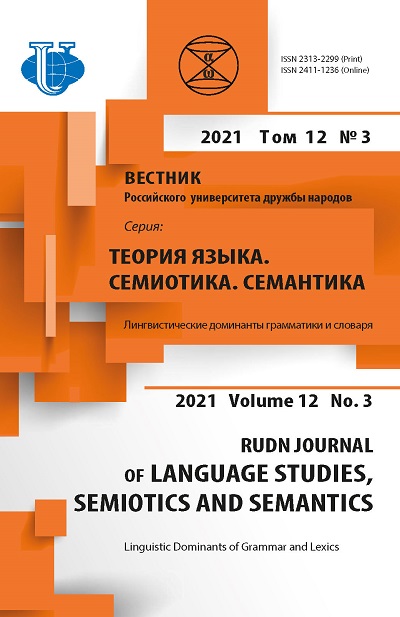“Russian Bear” in the Spanish-Language Media Discourse
- Authors: Kleshchenko L.L.1
-
Affiliations:
- The Herzen State Pedagogical University of Russia
- Issue: Vol 12, No 3 (2021): Linguistic dominants of grammar and lexics
- Pages: 806-822
- Section: DISCOURSIVE PRACTICES AND TEXT ANALYSIS
- URL: https://journals.rudn.ru/semiotics-semantics/article/view/27574
- DOI: https://doi.org/10.22363/2313-2299-2021-12-3-806-822
Cite item
Full Text
Abstract
The article examines the role of the bear metaphor in the Spanish-language political discourse. The relevance of the study is due, firstly, to the intensification of cooperation between Russia and Latin American countries, the effectiveness of which can be influenced by stereotypes and political symbols. Secondly, the growing popularity of the use of zoomorphic metaphors by the mass media. One of the unofficial symbols of Russia, which is often addressed by both traditional media and social media, is the bear. The “Russian Bear” metaphor is now widely used in both Russian and foreign periodicals and cartoons. The purpose of this research is to identify the specifics of the representation of the image of Russia as a bear in the Ibero-American political mass-media discourse. The source for the analysis is a Spanish-language media discourse (cases: the 2014 Ukrainian crisis, the Venezuelan crisis, Russia’s military operation in Syria, Russia’s interference in the elections in Mexico). The scientific novelty of the study is that for the first time in the Russian-language scientific literature, the features of the use of the bear metaphor by Latin American media and social media are examined. The author concludes that the metaphor “Russian Bear” is used both in the internal political symbolic struggle and in the foreign policy discourse. The specifics of the use of the bear metaphor in Latin America are mainly determined by political orientations: for example, the left traditionally considers Russia as an ally, appealing to such meanings of the bear metaphor as strength, justice, and the ability to become a defender against aggressors. In turn, their opponents use a bear metaphor to label left-wing politicians as traitors to the national interest. In this context, the image of a Bear serves as a symbolic border guard. The bear metaphor can be used to create an image of an ally and defender, as well as an enemy. The Ibero-American media turn to the bear metaphor mainly in the headlines and subheadings of materials devoted to Russian foreign policy, which allows them to draw readers’ attention to the topic under consideration.
About the authors
Liudmila L. Kleshchenko
The Herzen State Pedagogical University of Russia
Author for correspondence.
Email: ludmila.popova2011@yandex.ru
ORCID iD: 0000-0002-4172-6583
PhD of Political sciences, Senior lecturer of the Department of the Political science of the Institute of History and Social Sciences
191186, Russian Federation, Saint Petersburg, Moika river embankment, 48 building 20References
- Ustinova, O.V. (2018). The representation of Canada in political discourse. RUDN Journal of Language Studies Semiotics and Semantics, 9(1), 136—157. doi: 10.22363/2313-2299-2018-9-1-136-157 (In Russ.).
- Scocozza, C. (2019). El retorno del “Oso” a América Latina. La política rusa en Venezuela. Cultura Latinoamericana, 30(2), 58—73. (In Spanish).
- Rossomakhin, A.A. & Khrustalev, D.G. (2008). Russia as a Bear: The Origins of visualization (XVI—XVIII centuries). In: Borders: Almanac of the Center for Ethnic and National Studies of IVSU. Issue 2: Visualization of the nation. Ivanovo: IVSU. pp. 123—161. (In Russ.).
- Lazari, A. de & Ryabov, O.V. (2008). Russian Bear in Polish satirical graphics of the interwar period (1919—1939). In: Borders: Almanac of the Center for Ethnic and National Studies of IVSU. Issue 2: Visualization of the nation. Ivanovo: IVSU. pp. 162—182. (In Russ.).
- Riabov, O.V. (2009). Hunting the bear: on the role of symbols in the political struggle. Emergency reserve, 1, 195—211. (In Russ.).
- Riabova, T.B. (2012). The bear as a symbol of Russia: the sociological dimension. In: “Russian Bear”: history, semiotics, politics, O.V. Ryabov and A. de Lazari (eds.). Moscow. pp. 338—353. (In Russ.).
- Tsykalov, D.E. (2013). The image of the “Russian bear” in the Russian caricature of the period of the First World War (July 1914—February 1917). Labyrinth. Journal of Social and Humanitarian Studies, 4, 68—80. (In Russ.).
- Riabov, O.V. (2016). Medvezhya metaphor of Russia as a factor of international relations. Cultural linguistics, 10, 315—333. (In Russ.).
- Smirnov, D.G. (2020). The image of the Russian bear in the system of Russian ecosemiotics: the first approximation. Bulletin of the Ivanovo State University. Issue 2 (20). pp. 97—103. (In Russ.).
- Sala, I.G. (2012). Echoes of the bear’s growl: The Russian Empire as a white bear in the Spanish press. “Russian Bear”: history, semiotics, politics. Riabov O., de Lazari A. (ed.), Moscow: Novoe literaturnoe obozrenie. pp. 140—149. (In Russ.).
- Gailite, G. (2013). The Bear and Latvia: images of Latvian-Russian relations in caricature. Labyrinth. Journal of Social and Humanitarian Studies, 4, 29—40. (In Russ.).
- Babkina, V.A. (2017). The bear metaphor in the discourse of German media. Questions of theory and practice, 11—3(77), 60—62. (In Russ.).
- Budaev, E.V. & Chudinov, A.P. (2009). Metaphor in political interdiscourse. Yekaterinburg. (In Russ.).
- Lakoff, J. & Johnson, M. (1990). Metaphors by which we live. Theory of Metaphor, N.D. Arutyunova, M.A. Zhurinskaya (eds.). Moscow: Progress. pp. 387—415. URL: http://www.metaphor.nsu.ru/lacoff_1.htm (accessed: 10.10.2020).
- Musolff, A. (2011). Metaphor in political dialogue. Language and Dialogue, 1(2), 191—206.
- Krivtsova, L.A. (2012). Bear in the post-Soviet art: the semantics and pragmatics of the image. “Russian bear”: history, semiotics, politics. Ed. by: Riabov O., Lazari A. de (ed.), Moscow: Novoe literaturnoe obozrenie. (In Russ.).
- Zernova, E.S. (2020) Linguistic modeling of Russia’s foreign policy image in the media space of Latin America (based on the media of Venezuela, Mexico and Chile). Ancient and New Romania. Issue 25. pp. 42—64. (In Russ.).
- Lakoff, J. (2006) Metaphor and War: A system of metaphors to justify the Gulf War. Modern political Linguistics. ed. by E. V. Budaev, A. P. Chudinov. Yekaterinburg: USPU, pp. 59—71. URL: www.philology.ru/linguistics1/lakoff-06.htm (accessed 10.10.2020). (In Russ.).
Supplementary files





















